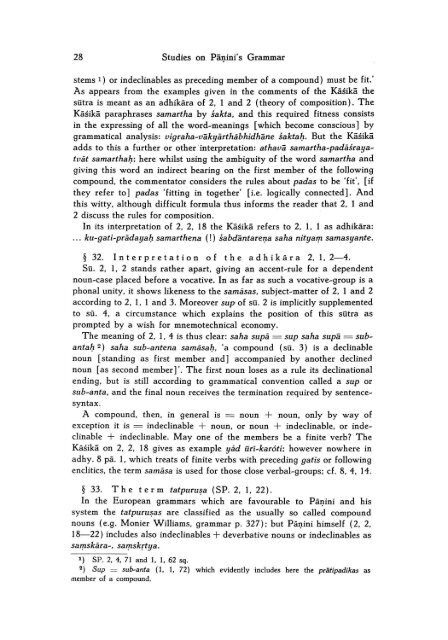Studies on Panini's grammar - DWC
Studies on Panini's grammar - DWC
Studies on Panini's grammar - DWC
You also want an ePaper? Increase the reach of your titles
YUMPU automatically turns print PDFs into web optimized ePapers that Google loves.
28 <str<strong>on</strong>g>Studies</str<strong>on</strong>g> <strong>on</strong> PáI].ini's Grammar<br />
stems 1) or indeclinables as preceding member of a compound) must be fit:<br />
As appears from the examples given in the comments of the Käsikä the<br />
sutra is meant as an adhikära of 2, 1 and 2 (theory of compositi<strong>on</strong>). The<br />
Käsiká paraphrases samartha by sakta, and this required fitness c<strong>on</strong>sists<br />
in the expressing of all the word~meanings [which become c<strong>on</strong>scious] by<br />
grammatical analysis: vigraha~väkyärthäbhidhäne saktaf;. But the Kásiká<br />
adds to this a further or other ' interpretati<strong>on</strong>: athavä samartha~padäSraya~<br />
tvät samarthaf;; here whilst using the ambiguity of the word samartha and<br />
giving this word an indirect bearing <strong>on</strong> the first member of the fo11owing<br />
compound, the commentator c<strong>on</strong>siders the rules about padas to be 'fit', [if<br />
they refer to] padas . fitting in together' [i.e. logica11y c<strong>on</strong>nected] . And<br />
th is witty, although difficult formula thus informs the reader that 2, 1 and<br />
2 discuss the rules for compositi<strong>on</strong>.<br />
In its interpretati<strong>on</strong> of 2, 2, 18 the Käsikä refers to 2, I, 1 as adhikära:<br />
... ku~gati~prädayaf; samarthena (!) sabdäntare1J.a saha nityaf!1 samasyante.<br />
§ 32. Interpretati<strong>on</strong> of the adhikära 2, 1,2-4.<br />
Su. 2, I, 2 stands rather apart, giving an accent~rule for a dependent<br />
noun~case placed before a vocative. In as far as such a vocative~group is a<br />
ph<strong>on</strong>al unity, it shows likeness to the samäsas, subject~matter of 2, 1 and 2<br />
according to 2, I, 1 and 3. Moreover sup of su. 2 is implicitly supplemented<br />
to sÜ. 4, a circumstance which explains the positi<strong>on</strong> of this sutra as<br />
prompted by a wish for mnemotechnical ec<strong>on</strong>omy.<br />
The meaning of 2, I, 4 is thus clear: saha supä = sup saha supä = sub~<br />
antaf; 2) saha sub~antena samäsaf;, • a compound (su. 3) is a declinable<br />
noun [standing as first member and] accompanied by another declined<br />
noun [as sec<strong>on</strong>d member] '. The first noun loses as a rule its declinati<strong>on</strong>al<br />
ending, but is still according to grammatical c<strong>on</strong>venti<strong>on</strong> called a sup or<br />
sub~anta, and the fin al noun receives the terminati<strong>on</strong> required by sentence~<br />
syntax.<br />
A compound, then, in general is = noun + noun, <strong>on</strong>ly by way of<br />
indeclinable + noun, or noun + indeclinable, or inde~<br />
excepti<strong>on</strong> it is =<br />
clinable + indeclinable. May <strong>on</strong>e of the members be a finite verb? The<br />
Käsikä <strong>on</strong> 2, 2, 18 gives as example yád ïiri~karóti; however nowhere in<br />
adhy. 8 pä. I, which treats of finite verbs with preceding gatis or fo11owing<br />
enclitics, the term samäsa is used for those close verbal~groups; cf. 8, 4, 14.<br />
§ 33. Th e ter m tatpuru~a (SP. 2, I, 22).<br />
In the European <strong>grammar</strong>s which are favourable to PäI].ini and his<br />
system the tatpuru~as are classified as the usually so called compound<br />
nouns (e.g. M<strong>on</strong>ier Williams, <strong>grammar</strong> p. 327); but PäI].ini himself (2,2,<br />
18-22) includes also indeclinables + deverbative nouns or indeclinables as<br />
saf!1skära~, saf!1skrtya.<br />
1) SP. 2, 'I, 71 and 1, 1. 62 sq.<br />
2) Sup = sub-anta (1, 1, 72) which evidently includes here the prätipadikas as<br />
member of a compound.
















